Attached files
| file | filename |
|---|---|
| 8-K - FORM 8-K - ARCH RESOURCES, INC. | c63295e8vk.htm |
Exhibit 99.1
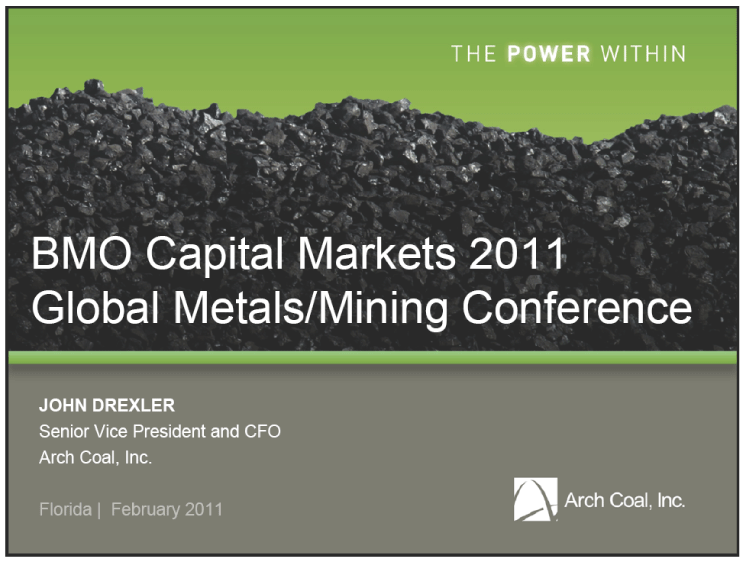
| BMO Capital Markets 2011 Global Metals/Mining Conference JOHN DREXLER Senior Vice President and CFO Arch Coal, Inc. Florida | February 2011 |
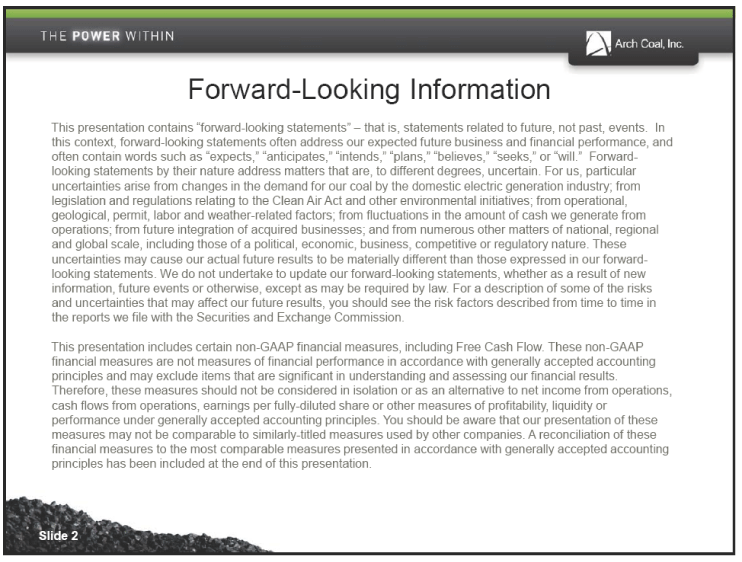
| Forward-Looking Information This presentation contains “forward-looking statements” — that is, statements related to future, not past, events. In this context, forward-looking statements often address our expected future business and financial performance, and often contain words such as “expects,” “anticipates,” “intends,” “plans,” “believes,” “seeks,” or “will.” Forward-looking statements by their nature address matters that are, to different degrees, uncertain. For us, particular uncertainties arise from changes in the demand for our coal by the domestic electric generation industry; from legislation and regulations relating to the Clean Air Act and other environmental initiatives; from operational, geological, permit, labor and weather-related factors; from fluctuations in the amount of cash we generate from operations; from future integration of acquired businesses; and from numerous other matters of national, regional and global scale, including those of a political, economic, business, competitive or regulatory nature. These uncertainties may cause our actual future results to be materially different than those expressed in our forward-looking statements. We do not undertake to update our forward-looking statements, whether as a result of new information, future events or otherwise, except as may be required by law. For a description of some of the risks and uncertainties that may affect our future results, you should see the risk factors described from time to time in the reports we file with the Securities and Exchange Commission. This presentation includes certain non-GAAP financial measures, including Free Cash Flow. These non-GAAP financial measures are not measures of financial performance in accordance with generally accepted accounting principles and may exclude items that are significant in understanding and assessing our financial results. Therefore, these measures should not be considered in isolation or as an alternative to net income from operations, cash flows from operations, earnings per fully-diluted share or other measures of profitability, liquidity or performance under generally accepted accounting principles. You should be aware that our presentation of these measures may not be comparable to similarly-titled measures used by other companies. A reconciliation of these financial measures to the most comparable measures presented in accordance with generally accepted accounting principles has been included at the end of this presentation. |
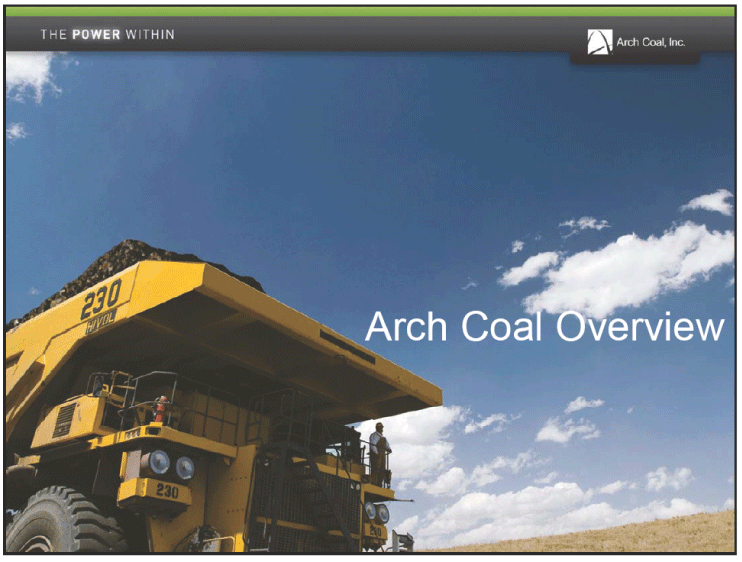
| Arch Coal Overview |
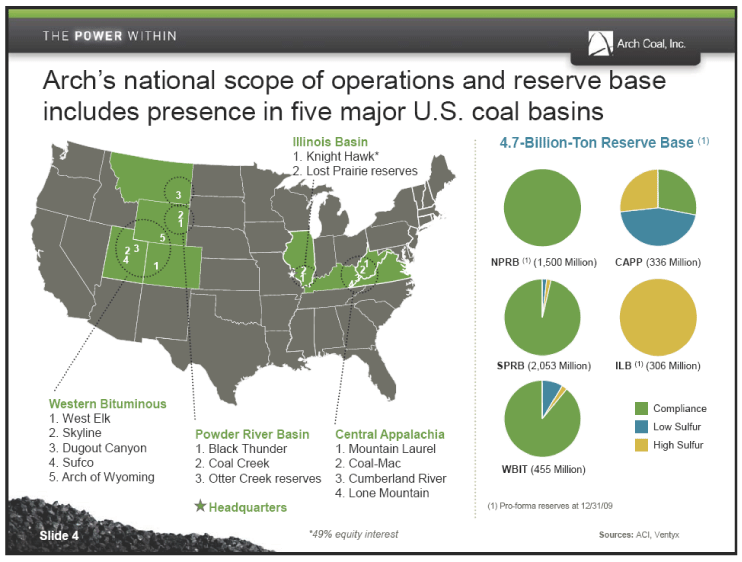
| Arch’s national scope of operations and reserve base includes presence in five major U.S. coal basins Illinois Basin 4.7-Billion-Ton Reserve Base (1) 1. Knight Hawk* 2. Lost Prairie reserves 3 2 1 5 2 3 4 1 2 2 1 NPRB (1) (1,500 Million) CAPP (336 Million) 1 3 4 SPRB (2,053 Million) ILB (1) (306 Million) Western Bituminous Compliance 1. West Elk 2. Skyline Powder River Basin Central Appalachia Low Sulfur 3. Dugout Canyon 1. Black Thunder 1. Mountain Laurel High Sulfur 4. Sufco 2. Coal Creek 2. Coal-Mac WBIT (455 Million) 5. Arch of Wyoming 3. Otter Creek reserves 3. Cumberland River 4. Lone Mountain Headquarters (1) Pro-forma reserves at 12/31/09 |
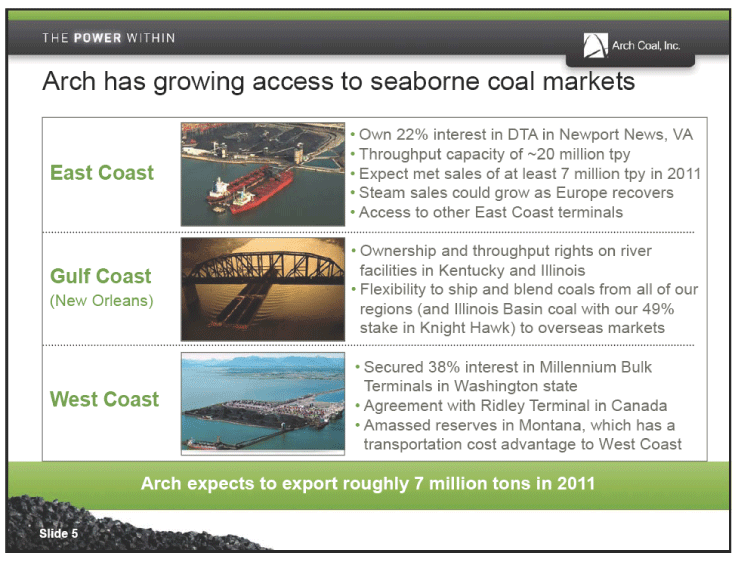
| Arch has growing access to seaborne coal markets • Own 22% interest in DTA in Newport News, VA • Throughput capacity of ~20 million tpy East Coast • Expect met sales of at least 7 million tpy in 2011 • Steam sales could grow as Europe recovers • Access to other East Coast terminals • Ownership and throughput rights on river Gulf Coast facilities in Kentucky and Illinois • Flexibility to ship and blend coals from all of our (New Orleans) regions (and Illinois Basin coal with our 49% stake in Knight Hawk) to overseas markets • Secured 38% interest in Millennium Bulk Terminals in Washington state West Coast • Agreement with Ridley Terminal in Canada • Amassed reserves in Montana, which has a transportation cost advantage to West Coast Arch expects to export roughly 7 million tons in 2011 |
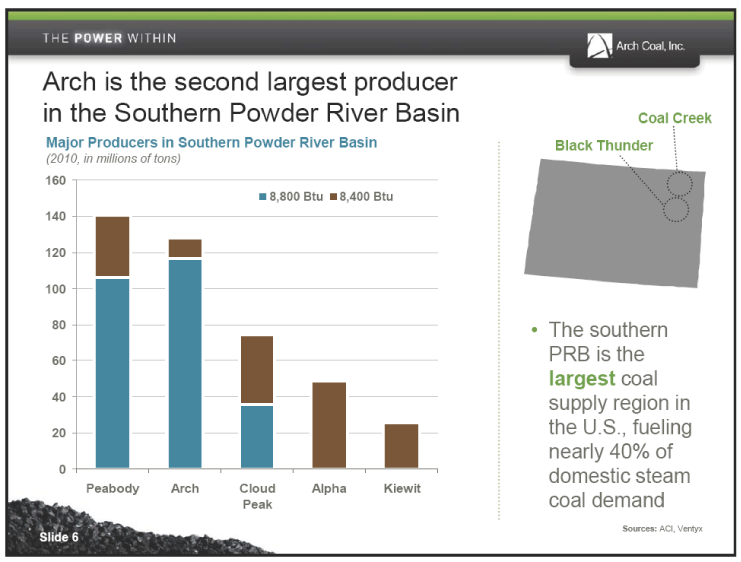
| Arch is the second largest producer in the Southern Powder River Basin Coal Creek Major Producers in Southern Powder River Basin Black Thunder (2010, in millions of tons) 160 8,800 Btu 8,400 Btu 140 120 100 80 • The southern 60 PRB is the largest coal 40 supply region in 20 the U.S., fueling nearly 40% of 0 domestic steam Peabody Arch Cloud Alpha Kiewit Peak coal demand Sources: ACI, Ventyx Slide 6 |
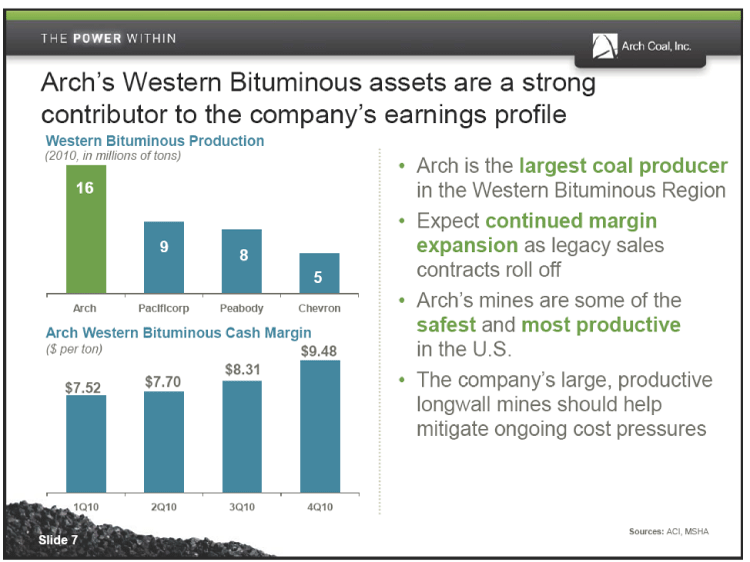
| Arch’s Western Bituminous assets are a strong contributor to the company’s earnings profile Western Bituminous Production (2010, in millions of tons) • Arch is the largest coal producer 16 in the Western Bituminous Region • Expect continued margin 9 expansion as legacy sales 8 5 contracts roll off Arch Pacificorp Peabody Chevron • Arch’s mines are some of the Arch Western Bituminous Cash Margin safest and most productive ($ per ton) $9.48 in the U.S. $7.70 $8.31 $7.52 • The company’s large, productive longwall mines should help mitigate ongoing cost pressures 1Q10 2Q10 3Q10 4Q10 Sources: ACI, MSHA Slide 7 |
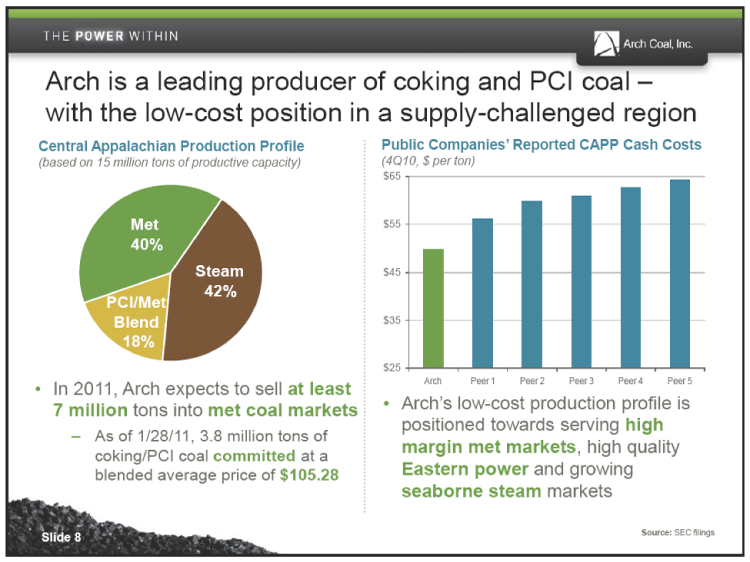
| Arch is a leading producer of coking and PCI coal —with the low-cost position in a supply-challenged region Central Appalachian Production Profile Public Companies’ Reported CAPP Cash Costs (based on 15 million tons of productive capacity) (4Q10, $ per ton) $65 Met $55 40% Steam $45 42% PCI/Met Blend $35 18% $25 • In 2011, Arch expects to sell at least Arch Peer 1 Peer 2 Peer 3 Peer 4 Peer 5 7 million tons into met coal markets • Arch’s low-cost production profile is positioned towards serving high — As of 1/28/11, 3.8 million tons of margin met markets, high quality coking/PCI coal committed at a blended average price of $105.28 Eastern power and growing seaborne steam markets |
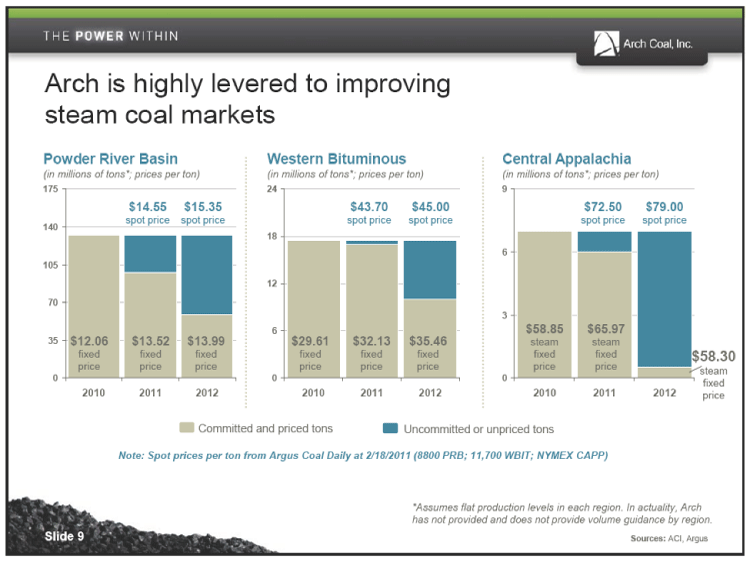
| Arch is highly levered to improving steam coal markets Powder River Basin Western Bituminous Central Appalachia (in millions of tons*; prices per ton) (in millions of tons*; prices per ton) (in millions of tons*; prices per ton) 175 16 24 9 $14.55 $15.35 $43.70 $45.00 $72.50 $79.00 spot price spot price spot price spot price spot price spot price 140 9 18 8 6 105 12 5 70 3 6 $58.85 $65.97 35 $12.06 $13.52 $13.99 $29.61 $32.13 $35.46 steam steam fixed fixed fixed fixed fixed fixed fixed fixed $58.30 price price price price price price price price steam 0 0 0 2010 2011 2012 2010 2011 2012 2010 2011 2012 fixed price Committed and priced tons Uncommitted or unpriced tons Note: Spot prices per ton from Argus Coal Daily at 2/18/2011 (8800 PRB; 11,700 WBIT; NYMEX CAPP) *Assumes flat production levels in each region. In actuality, Arch has not provided and does not provide volume guidance by region. Slide 9 Sources: ACI, Argus |
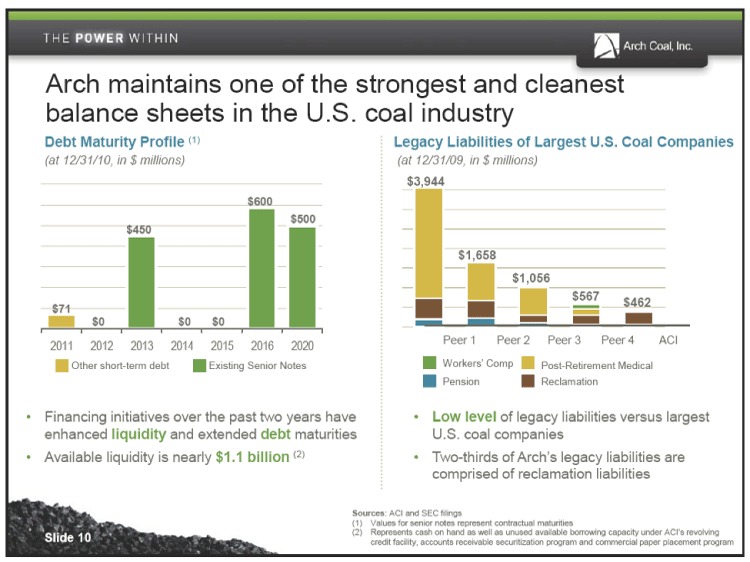
| Arch maintains one of the strongest and cleanest balance sheets in the U.S. coal industry Debt Maturity Profile (1) Legacy Liabilities of Largest U.S. Coal Companies (at 12/31/10, in $ millions) (at 12/31/09, in $ millions) $3,944 $600 $450 $500 $1,658 $1,056 $567 $462 $71 $0 $0 $0 2011 2012 2013 2014 2015 2016 2020 Peer 1 Peer 2 Peer 3 Peer 4 ACI Other short-term debt Existing Senior Notes Workers’ Comp Post-Retirement Medical Pension Reclamation • Financing initiatives over the past two years have • Low level of legacy liabilities versus largest enhanced liquidity and extended debt maturities U.S. coal companies • Available liquidity is nearly $1.1 billion (2) • Two-thirds of Arch’s legacy liabilities are comprised of reclamation liabilities Sources: ACI and SEC filings (1) Values for senior notes represent contractual maturities Slide 10 (2) Represents cash on hand as well as unused available borrowing capacity under ACI’s revolving credit facility, accounts receivable securitization program and commercial paper placement program |
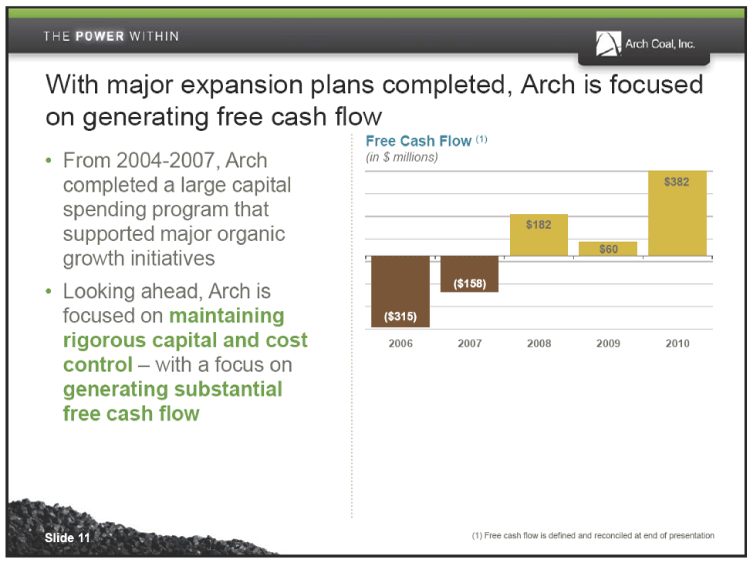
| With major expansion plans completed, Arch is focused on generating free cash flow Free Cash Flow (1) • From 2004-2007, Arch (in $ millions) completed a large capital $382 spending program that supported major organic $182 growth initiatives $60 • Looking ahead, Arch is ($158) focused on maintaining ($315) rigorous capital and cost 2006 2007 2008 2009 2010 control — with a focus on generating substantial free cash flow Slide 11 (1) Free cash flow is defined and reconciled at end of presentation |
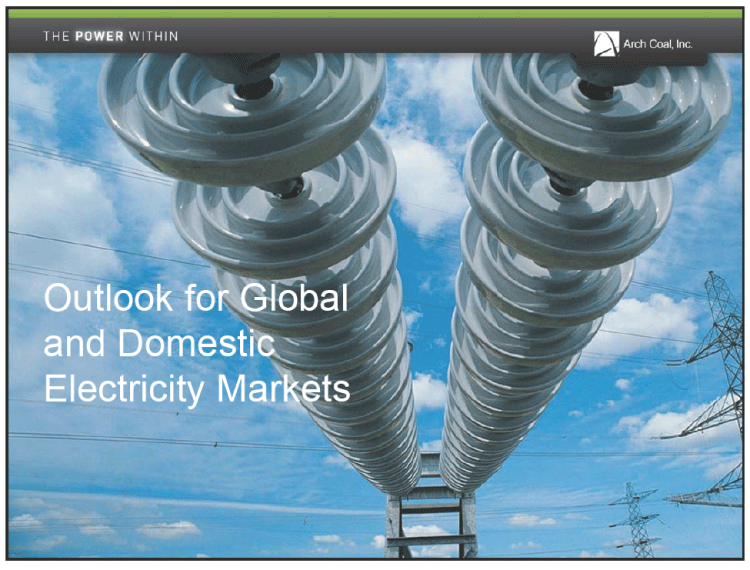
| Outlook for Global and Domestic Electricity Markets |
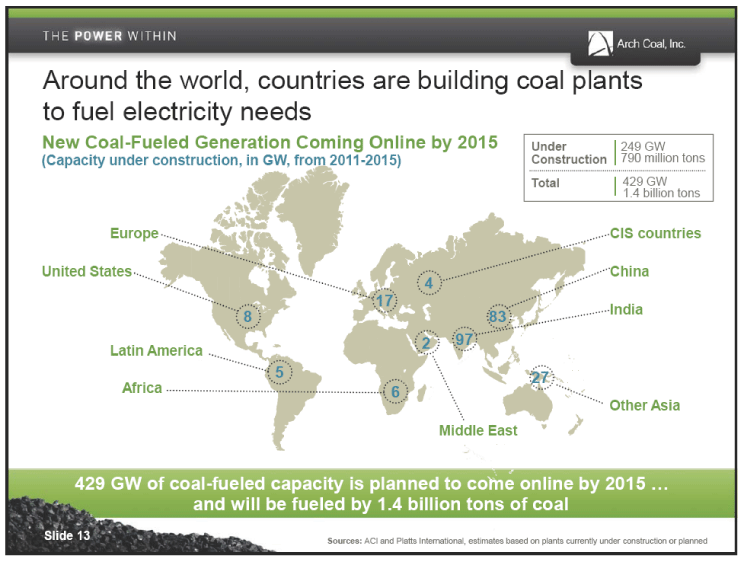
| Around the world, countries are building coal plants to fuel electricity needs New Coal-Fueled Generation Coming Online by 2015 Under 249 GW (Capacity under construction, in GW, from 2011-2015) Construction 790 million tons Total 429 1.4 billion GW tons Europe CIS countries United States China 4 17 8 83 India 2 97 Latin America 5 27 Africa 6 Other Asia Middle East 429 GW of coal-fueled capacity is planned to come online by 2015 ... and will be fueled by 1.4 billion tons of coal Slide 13 Sources: ACI and Platts International, estimates based on plants currently under construction or planned |
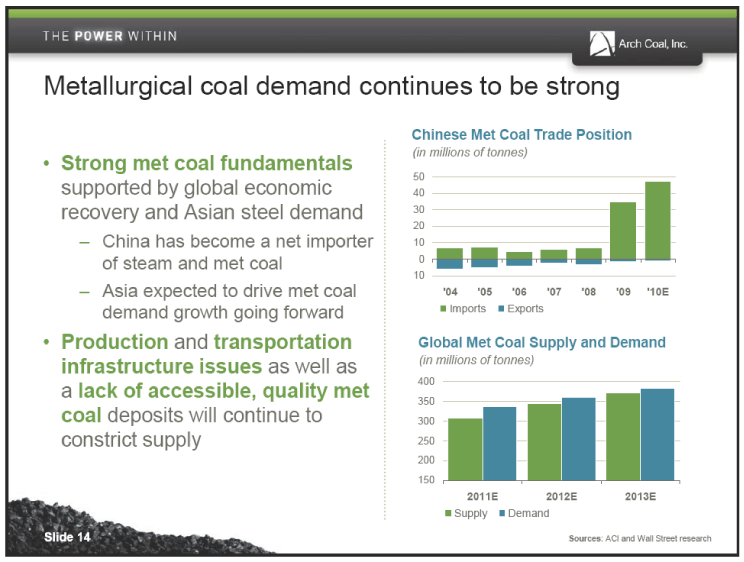
| Metallurgical coal demand continues to be strong Chinese Met Coal Trade Position (in millions of tonnes) • Strong met coal fundamentals 50 supported by global economic 40 recovery and Asian steel demand 30 20 — China has become a net importer 10 of steam and met coal 0 10 — Asia expected to drive met coal ‘04 ‘05 ‘06 ‘07 ‘08 ‘09 ‘10E demand growth going forward Imports Exports • Production and transportation Global Met Coal Supply and Demand infrastructure issues as well as (in millions of tonnes) a lack of accessible, quality met 400 coal deposits will continue to 350 300 constrict supply 250 200 150 2011E 2012E 2013E Supply Demand Slide 14 Sources: ACI and Wall Street research |
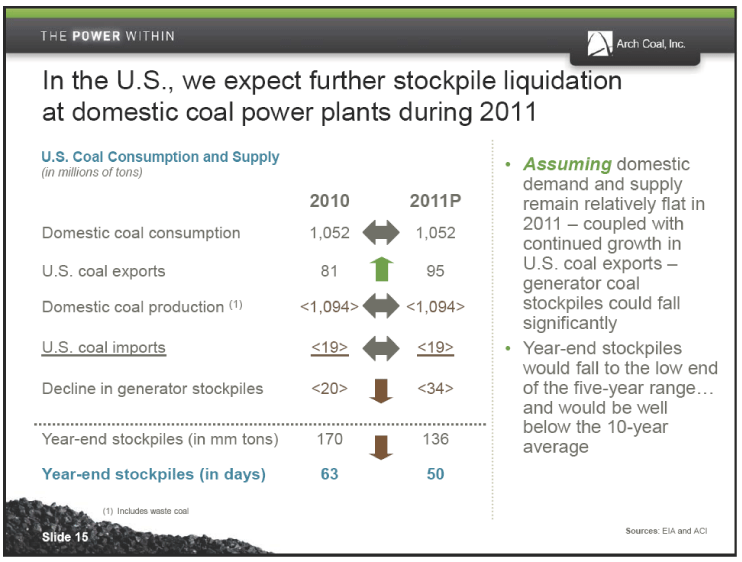
| In the U.S., we expect further stockpile liquidation at domestic coal power plants during 2011 U.S. Coal Consumption and Supply • Assuming domestic (in millions of tons) 2010 2011P demand and supply remain relatively flat in 2011 — coupled with Domestic coal consumption 1,052 1,052 continued growth in U.S. coal exports 81 95 U.S. coal exports —generator coal Domestic coal production (1) <1,094> <1,094> stockpiles could fall significantly U.S. coal imports <19> <19> • Year-end stockpiles would fall to the low end Decline in generator stockpiles <20> <34> of the five-year range... and would be well below the 10-year Year-end stockpiles (in mm tons) 170 136 average Year-end stockpiles (in days) 63 50 (1) Includes waste coal Slide 15 Sources: EIA and ACI |
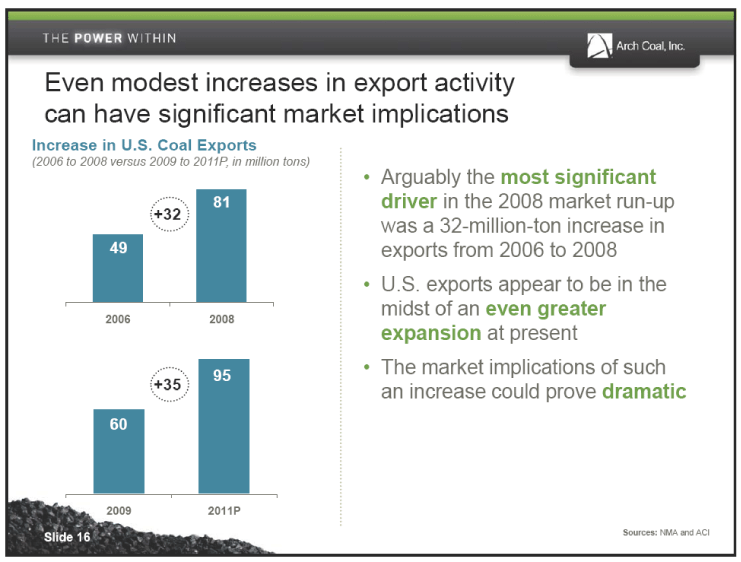
| Even modest increases in export activity can have significant market implications Increase in U.S. Coal Exports (2006 to 2008 versus 2009 to 2011P, in million tons) • Arguably the most significant 81 driver in the 2008 market run-up +32 was a 32-million-ton increase in 49 exports from 2006 to 2008 • U.S. exports appear to be in the midst of an even greater 2006 2008 expansion at present 95 • The market implications of such +35 an increase could prove dramatic 60 2009 2011P Slide 16 Sources: NMA and ACI |
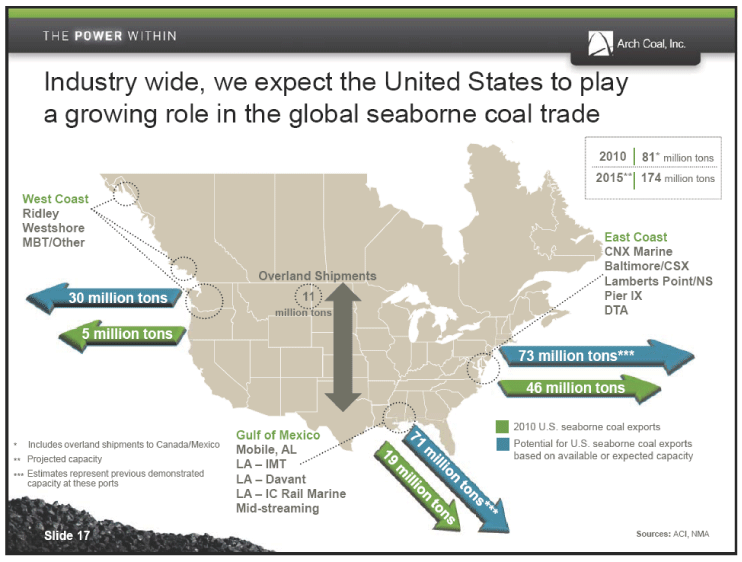
| Industry wide, we expect the United States to play a growing role in the global seaborne coal trade 2010 81* million tons 2015** 174 million tons West Coast Ridley Westshore East Coast MBT/Other CNX Marine Baltimore/CSX Overland Shipments Lamberts Point/NS 30 million tons 11 Pier IX 20 mt million tons DTA 5 million tons 73 million tons*** 73 46 mt million tons 2010 U.S. seaborne coal exports Gulf of Mexico * Includes overland shipments to Canada/Mexico Potential for U.S. seaborne coal exports Mobile, AL Projected capacity based on available or expected capacity ** LA — IMT *** Estimates represent previous demonstrated LA — Davant capacity at these ports LA — IC Rail Marine Mid-streaming Slide 17 Sources: ACI, NMA |
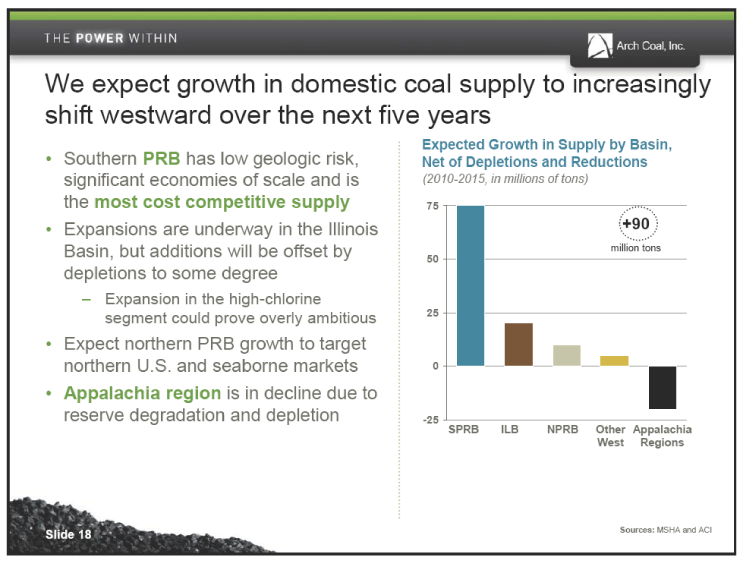
| We expect growth in domestic coal supply to increasingly shift westward over the next five years Expected Growth in Supply by Basin, • Southern PRB has low geologic risk, Net of Depletions and Reductions significant economies of scale and is (2010-2015, in millions of tons) the most cost competitive supply 75 • Expansions are underway in the Illinois +90 Basin, but additions will be offset by million tons depletions to some degree 50 — Expansion in the high-chlorine segment could prove overly ambitious 25 • Expect northern PRB growth to target northern U.S. and seaborne markets 0 • Appalachia region is in decline due to reserve degradation and depletion -25 SPRB ILB NPRB Other Appalachia West Regions Slide 18 Sources: MSHA and ACI |
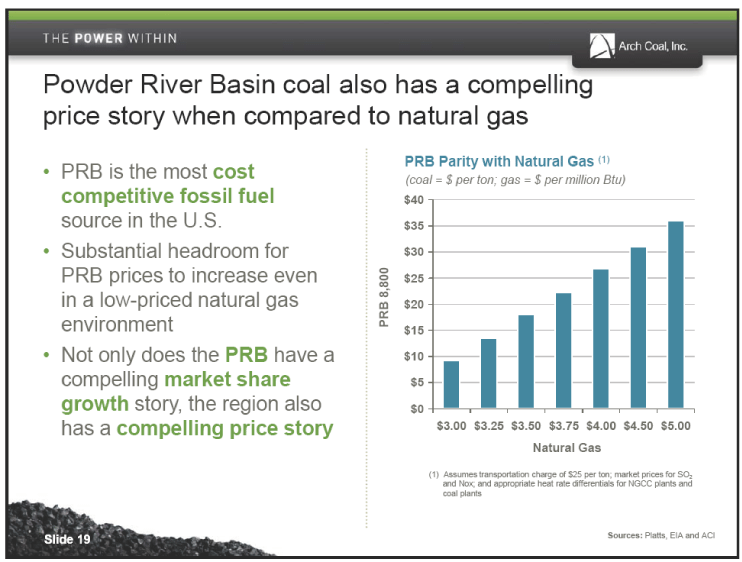
| Powder River Basin coal also has a compelling price story when compared to natural gas PRB Parity with Natural Gas (1) • PRB is the most cost (coal = $ per ton; gas = $ per million Btu) competitive fossil fuel $40 source in the U.S. $35 • Substantial headroom for $30 PRB prices to increase even 8,800 $25 in a low-priced natural gas PRB $20 environment $15 • Not only does the PRB have a $10 compelling market share $5 growth story, the region also $0 has a compelling price story $3.00 $3.25 $3.50 $3.75 $4.00 $4.50 $5.00 Natural Gas (1) Assumes transportation charge of $25 per ton; market prices for SO2 and Nox; and appropriate heat rate differentials for NGCC plants and coal plants Slide 19 Sources: Platts, EIA and ACI |
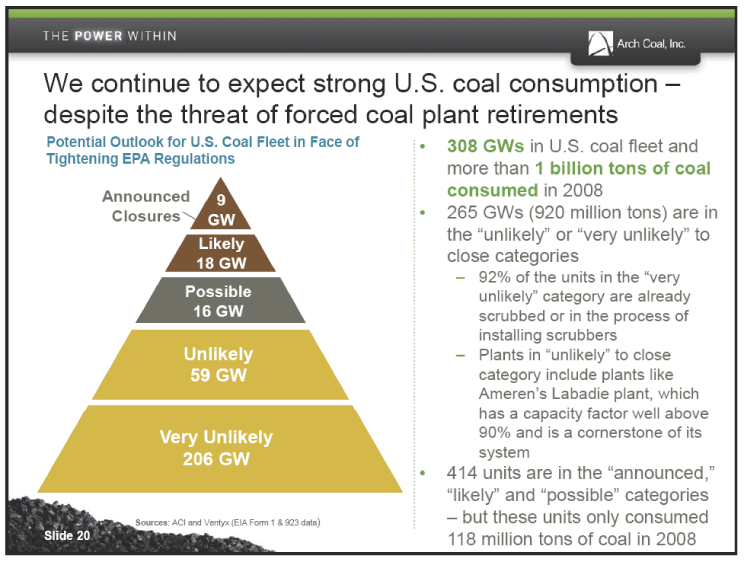
| We continue to expect strong U.S. coal consumption —despite the threat of forced coal plant retirements Potential Outlook for U.S. Coal Fleet in Face of • 308 GWs in U.S. coal fleet and Tightening EPA Regulations more than 1 billion tons of coal Announced consumed in 2008 9 Closures GW • 265 GWs (920 million tons) are in the “unlikely” or “very unlikely” to Likely 18 GW close categories 18 MW Possible — 92% of the units in the “very 16 GW MW unlikely” category are already scrubbed or in the process of installing scrubbers Unlikely — Plants in “unlikely” to close 59 59MW GW category include plants like Ameren’s Labadie plant, which has a capacity factor well above Very Unlikely 90% and is a cornerstone of its 206 GW MW system MW • 414 units are in the “announced,” “likely” and “possible” categories Sources: ACI and Ventyx (EIA Form 1 & 923 data) — but these units only consumed Slide 20 118 million tons of coal in 2008 |
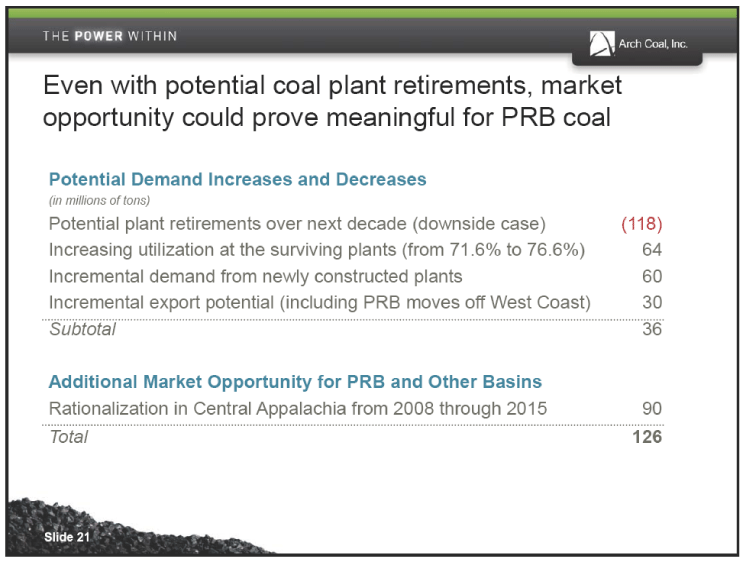
| Even with potential coal plant retirements, market opportunity could prove meaningful for PRB coal Potential Demand Increases and Decreases (in millions of tons) Potential plant retirements over next decade (downside case) (118) Increasing utilization at the surviving plants (from 71.6% to 76.6%) 64 Incremental demand from newly constructed plants 60 Incremental export potential (including PRB moves off West Coast) 30 Subtotal 36 Additional Market Opportunity for PRB and Other Basins Rationalization in Central Appalachia from 2008 through 2015 90 Total 126 Slide 21 |
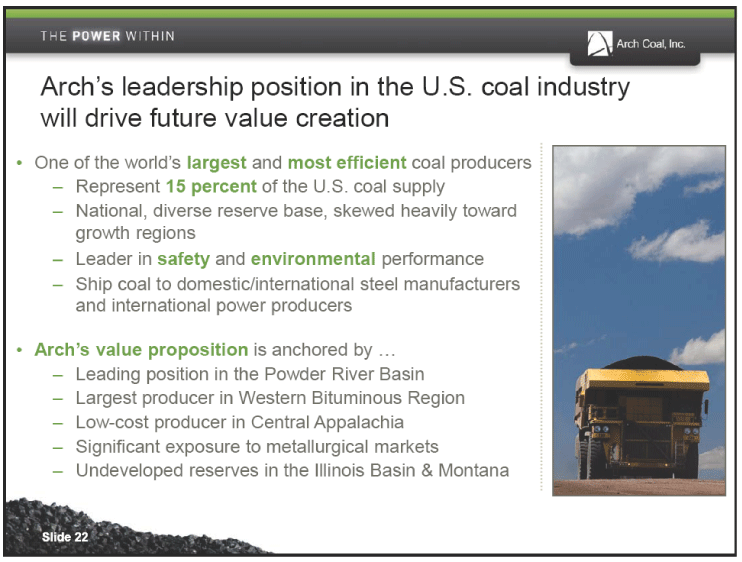
| Arch’s leadership position in the U.S. coal industry will drive future value creation • One of the world’s largest and most efficient coal producers — Represent 15 percent of the U.S. coal supply — National, diverse reserve base, skewed heavily toward growth regions — Leader in safety and environmental performance — Ship coal to domestic/international steel manufacturers and international power producers • Arch’s value proposition is anchored by ... — Leading position in the Powder River Basin — Largest producer in Western Bituminous Region — Low-cost producer in Central Appalachia — Significant exposure to metallurgical markets — Undeveloped reserves in the Illinois Basin & Montana Slide 22 |

| BMO Capital Markets 2011 Global Metals/Mining Conference JOHN DREXLER Senior Vice President and CFO Arch Coal, Inc. Florida | February 2011 |
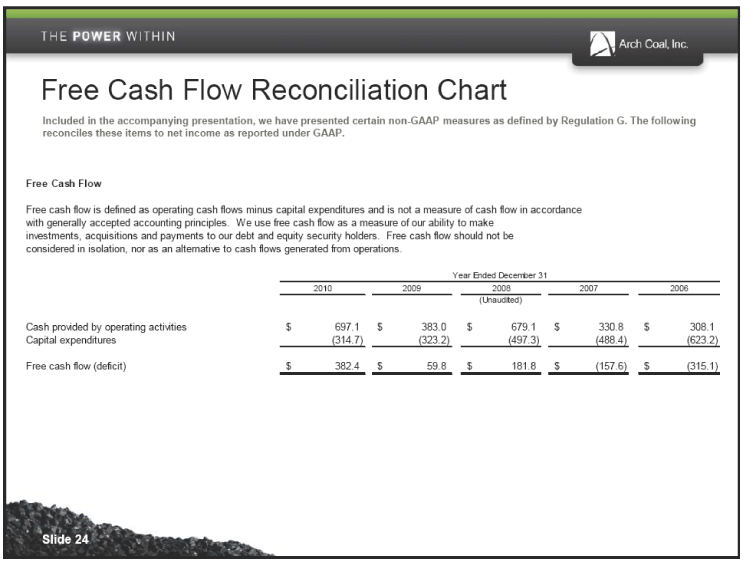
| Free Cash Flow Reconciliation Chart Included in the accompanying presentation, we have presented certain non-GAAP measures as defined by Regulation G. The following reconciles these items to net income as reported under GAAP. Free Cash Flow Free cash flow is defined as operating cash flows minus capital expenditures and is not a measure of cash flow in accordance with generally accepted accounting principles. We use free cash flow as a measure of our ability to make investments, acquisitions and payments to our debt and equity security holders. Free cash flow should not be considered in isolation, nor as an alternative to cash flows generated from operations. Year Ended December 31 2010 2009 2008 2007 2006 (Unaudited) Cash provided by operating activities $697.1 $383.0 $679.1 $330.8 $308.1 Capital expenditures (314.7) (323.2) (497.3) (488.4) (623.2) Free cash flow (deficit) $382.4 $59.8 $181.8 $ (157.6) $ (315.1) |
